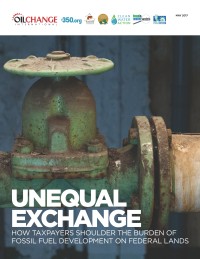Unequal Exchange: How Taxpayers Shoulder the Burden of Fossil Fuel Development on Federal Lands

The federal government of the United States remains custodian and manager of a large amount of fossil fuels on public lands. While sales of minerals do bring in some revenue to the government, there are many elements of federal management that result in artificially low realized revenues for taxpayers or subsidize extractive activities. Key findings of this review include:
- Fossil fuel production on federal lands – onshore and offshore territories – was subsidized to the tune of at least $7 billion in 2014. This number is likely a low estimate, as there were many subsidies that were identified but not quantified due to data limitations. It also does not include subsidies from the federal government and in the tax code not explicitly directed to fossil fuel production on federal lands.
- The ability of oil, gas, and coal producers to shift potential future liability onto taxpayers is also a major subsidy, but because it is difficult to calculate precisely, it is not included in the subsidy totals presented here. U.S. taxpayers’ contingent liability for decommissioning and cleanup of oil and gas projects in the Gulf of Mexico alone is estimated to be $35.3 billion by the Bureau of Ocean Energy Management (BOEM).
- Incorporating climate damage caused by fossil fuels produced on federal lands makes the economic argument for ending new leases on federal lands and waters even stronger. In the case of coal from the Powder River Basin, an area of active federal coal leases, every short ton of coal produced has a net cost to American taxpayers of $49 dollars. That means that Powder River Basin coal production alone – only a small sliver of fossil fuel production on federal lands nationwide – had a net cost to taxpayers of $17.8 billion in 2015, dwarfing the supposed economic benefits of allowing new fossil fuel leases on federal lands and waters.
- Removing these subsidies would save taxpayers money while also reducing greenhouse gas emissions from oil, gas, and coal production. The $7 billion in subsidies to fossil fuel companies could nearly double current support levels for mandatory computer science education programs for all public school students. It could pay for fixing the lead-contaminated water system in Flint, MI, and still cover the cost necessary for researchers to accelerate the development of new cancer detection and treatments – more than six times over.

